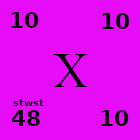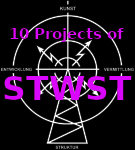 details.jpg)
r e a
My art is the practice of reclamation; a disruption of the colonial gaze through re-storying the blak-body as a point of
protest.’
For over three decades, r e a (they/them), a descendant of the Gamilaraay, Wailwan and Biripi peoples of New South Wales, has worked at the forefront of Indigenous new media practice and theory in Australia and internationally. An artist, curator, activist, researcher and cultural educator, r e a explores themes of Indigenous identity, representation and the post-colonial experience across mediums, which include: photography, digital media, sound, film, video and installation. Their creative research extends into the reclamation and reframing of the blak queer body, as they re-story Indigeneity and blakness!
r e a is the artist and author’s full name. Due to Western and academic naming conventions, some of r e a’s writings have been published under the names of: r e a Saunders and Dr Regina M. Saunders (Morris). r e a also uses the name r e a noir as a play on the colour blak and the French Impressionist painter Pierre-Auguste Renoir.
As an early adopter of digital processes, r e a started working with technology because it provided them with a space in which to locate their practice in what r e a called “unoccupied territories”. “One of the most important aspects of my digital new media arts practice has been to develop a range of new ways to speak.”
... because it was so new no one could categorise it or me—it gave me the freedom and potential to be an artist, not a queer artist, not an Indigenous artist, not even a woman artist, but an artist.
The freedom that r e a experienced in exploring the digital space challenged academic ideas, which believed that Indigenous people were "anti-technology" because essentially they were the "people of the past". The work of Indigenous artists reclaiming histories reminds us that "time exists in the past, present and future – simultaneously all at once". r e a is not a passive consumer of media; rather, they are an active creator, using experimental digital technologies to intentionally disrupt and disturb a history of silence.
One of their early projects, Look Who’s Calling The Kettle Black series (1992), used historical archival photos, found in her grandmothers’ files at The Aboriginal Protection Board of NSW & The New South Wales State Archives Collection. r e a used these images to make a series of digital prints, which speak to the oppressive policies that forced countless Aboriginal and Torres Strait Islander women and girls within the category of ‘domestic servants’. r e a was inspired by their grandmother to create this work, a distressing coda:
Many of these girls never…found their way back home and died in custody. My grandmother was lucky—she found her way
home.
Their most recent work; r e a: NATIVE (Griffith University Art Museum) comprises of two interrelated installations, which delve deeply into the historical and colonial archive. In the first room, a remastered iteration of r e a’s Native, 2013, a site-responsive sound and neon installation which was developed as part of an Indigenous Artist Residency at Blacktown Arts Centre in 2013. In the second gallery,
Native (yugal/song), 2024, incorporates video sound and motion sensors that enable the viewers to use their bodies to experience sound and then to perceive it in a visual form. The conceptual and physical touchstone of both installations is the Blacktown Native Institute, founded in Parramatta in 1815 and relocated to Blacktown in 1823, which was one of the first sites in Australia where Aboriginal children were removed from their parents and institutionalised. This ‘site’ resonated with r e a’s knowledge of their maternal grandmother’s experiences who was a child of The Stolen Generation. However, the project extends beyond this focal point, by offering broader reflections on how the body processes language when it is immersed in the archive – this work deliberately reclaims and Indigenises
r e a’s history, language and identity.
The Native exhibition coincided with the International Symposium on Electronic Arts (ISEA) Brisbane, 2024. The conference theme: ‘Everywhen’ explored the human perception of space and time. This word describes the notion that past, present and future all co-habit in any given location.
https://rea-noir.com
See further information:
r e a, Biddle, J. L., & Hibberd, L. (2023). The Artificial as an Intelligent
Indigenous/Indigenizing
System: The Experimental Art and Artifice of r e a. Visual Anthropology Review, 39(2), 458–474.
https://doi.org/10.1111/var.12284

